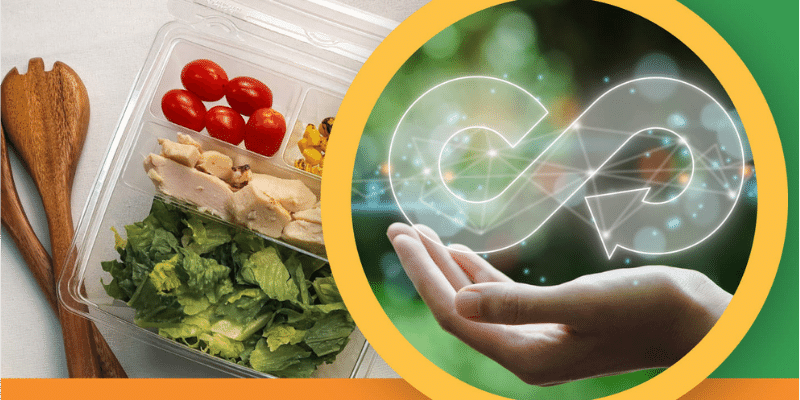
Sustainability is a key business focus today, with consumers seeking more environmentally-friendly products and alternatives to plastic food packaging than ever. Packing food offerings in recyclable containers is just one way that commercial food producers can meet this growing demand. There are several recyclable food packaging options available; however, some consumers need clarification about what these product terms mean. Food producers should see this as an opportunity to educate consumers and highlight their work to offer more sustainable packaging.
This post will discuss the different kinds of recyclable food containers and how to talk to the customer about recyclable plastic packaging.
What are Recyclable Food Containers?
Unlike single-use plastic packaging, recyclable food containers refer to packaging products that can be recycled after use. These recyclable containers can be made of plastic, cardboard, or glass. For this article, we will focus on plastic containers.
Why is Recyclable Food Packaging Important?
Using recyclable plastics not only helps reduce the amount of plastic waste entering landfills and oceans but also leads to lower greenhouse gas emissions from production processes. Consumers want products that, first and foremost, look good and are packaged in containers that can hold up to travel without breaking, leaking, or spilling. Beyond shelf appeal, food producers can differentiate their products with eco-friendly features. Using recyclable food packaging or designs that reduce the overall plastic used shows your company’s commitment to sustainability.
Commercial food producers are giving recyclable food packaging a look because it is essential in creating a more sustainable future and appeals to customers’ desire to make more eco-friendly buying decisions.
Types of Plastic Materials Used for Recyclable Food Containers
Among the specific plastic materials used for packaging food, some can be recycled, and some are made with varying percentages of recyclable plastic material. Recyclable plastic food containers have a recycling code on the package indicating the type of plastic used, such as recyclable PET. These codes help people know whether the packaging can be recycled in their area.
Recyclable plastic materials include:
- PET - Widely used to package food because it is sturdy and comes in various shapes, from boxes to bottles.
- HDPE 2 - Also commonly used for food packaging, such as milk jugs.
- Polypropylene - Used for reusable food storage containers and single-serving tubs. This type of plastic is microwave safe.
- LDPE 4 - Used in specific film seals, such as cling wrap.
Out of all these options, recyclable PET is the most common choice today for plastic food packaging. This thermoplastic polymer can be recycled up to seven times before it loses its structural integrity. PCR, or post-consumer resin, is another plastic often used for food packaging made from previously used and recycled plastic. PCR is a good option for sustainable packaging; however, recycling can be more challenging due to its high melting point.
Information Consumers Want to Know About Recyclable Food Packaging
There are many conflicting messages about plastic food containers and recyclable packaging today. Here are some common questions consumers ask about recycled plastics and how your packaging can provide answers.
What types of plastic food containers are recyclable?
Rules vary by municipality, but you can help guide consumers by noting which plastics are widely recyclable. Including messaging on packages, like 'This Package Is Recyclable' or using a significant recycling symbol, can show customers how to best dispose of used containers.
What is the difference between recyclable and compostable food containers?
Compostable food containers can break down in landfills over time, though slowly, while most plastics cannot. One exception is PLA, made partially with organic material like corn starch. PLA does not break down in landfills; PLA breaks down best in commercial composting facilities at high temperatures.
I hear most plastic doesn’t get recycled.
This is a concern for people today, as less than 10% of plastics used globally are recycled. However, companies like Lacerta are using PCR plastics in their sustainable packaging to help ensure recycled plastic is put to good use.
Do recyclable food containers cost more?
The cost of packaging depends on many factors but is often factored into the overall cost of the food item, and it is invisible to the consumer.
How to Choose the Proper Plastic Food Packaging
Here are some considerations when selecting plastic packaging for your food.
- Portion size - How much food must it hold?
- Shape - Are you using a clamshell, tray, or bowl?
- Shelf appeal - How will it look to the customer when displayed?
- Display - Where will it be displayed? What kind of case?
- Material - Is it sturdy enough to withstand travel? Does the plastic have high clarity and look appealing?
- Labeling - Where will the label go? What will it say?
Having a vendor with a design team helps with guiding you through these decisions. Lacerta offers design consultations with our skilled design team, often delivering a prototype turn-around time of one week.
Choosing the right packaging option today depends on a wide range of factors. While freshness, shelf appeal, and cost will always be the driving factors in a packaging decision, consumer demand for sustainability must also be considered. While any change can be disruptive, it’s also a way for companies to stand out, show off their values, and reach new audiences.





